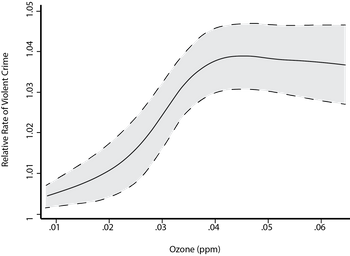This blog is the first in our new series, "Perspectives in Crime". We'll be exploring leading academic studies that touch on crime data.
New research shows that violent crime is aggravated by air pollution. This follows an increasing volume of academic research establishing air pollution’s adverse societal and health effects. Air pollution negatively impacts the physical, mental, and emotional development of children. It affects performance in terms of worker productivity and children’s standardized test scores, with long and short-term repercussions. Extensive work on the Lead-Crime theory found strong connections between interventions to reduce lead exposure and consequent reductions in crime rates in the mid-90s. This new research deepens connections between the air we breathe and societal ills.
Multiple recent academic studies have found correlations between aggressive behavior and pollutant exposure to carbon monoxide (CO) and nitrogen oxide (NO). These studies establish a causal link between pollutant exposure and violent crime, manifesting most significantly as violent criminal assaults. Significantly, the authors argue that curbing emissions could save hundreds of millions of dollars annually.
Here, we will explore two of these papers in some depth: a 2020 paper published in the American Economic Journal surveying air pollutants in Chicago at the neighborhood level (Herrnstadt et al, 2020), and a 2019 study using county level data from across the country, published in the Journal of Environmental Economics and Management (Burkhardt et al, 2019). These papers observe the impact of pollution on daily American life, and both determine a sense of its costs, generating a real dollar value of what stands to be gained by exposure mitigation.
Exposure to pollution may cause an increase in violent crime
Both studies measured exposure to particulate matter (PM), a mixture of organic and inorganic compounds, some components of which are directly toxic or linked with adverse health impacts. PM2.5, a category of fine particulate matter that both studies focus on, is about 30 times smaller than the width of a human hair (70 micrometers). The 2019 national study also surveyed ozone, the highly reactive gas composed of three oxygen atoms produced from electrical discharge. Experimental evidence links PM and ozone exposure to aggressive behavior, however the precise physiological pathways that produce this change are currently unknown.

Researchers leveraging crime statistics and atmospheric data in Chicago found air pollution produced an increase in violent crime on the neighborhood level, depending on which communities were downwind of daily pollution. By using the five interstates that bisect the city of Chicago, researchers analyzed daily wind patterns and daily crime data over 12 years, from 2001-2012. Using daily wind reports, researchers determined which neighborhoods were downwind from Interstate exhaust and Chicago’s industrial pollutant sources located to the southeast and southwest of the city. Both highly detailed datasets enabled researchers to compare crime on a neighborhood level and see how crime rates behaved with transport of pollutants.
The 2019 paper compared the FBI’s UCR crime statistics to pollution and ozone readings in 397 counties, working with data from 2006-2013. The smallest county in the sample has a population of 1,090, and the largest a population of 4,253,700. Altogether, sampled counties encompassed approximately 92 million people, 28.3% of the U.S. population and offered a granular view of the pollution/crime relationship in a variety of American communities.
These studies both found a statistical link between pollutant exposure and violent crime, especially aggravated assault. In Chicago, downwind neighborhoods experienced a 1.9% increase in violent crime. In the national study, a 10% increase of PM2.5 produced a 0.14% increase in aggravated assaults, while 10% increase in Ozone produced 0.3% increase. Burkhardt et al (2019) also found that increases in assault happened both inside and outside the home, arguing that high pollutant days also increased the incidence of domestic violence.
While both studies, carried out with different samples and distinct methodologies, they each reported relationships between pollution and aggravated assaults. Neither study found evidence that air pollution affected the property crimes of larceny, robbery, and car theft. The 2019 national study offered this in reflection “…we hypothesize that many property crimes are likely motivated by need, whereas assaults are more likely to be motivated by aggravation. A contemporaneous change in air pollution is unlikely to affect an individual’s incentive to steal, but it may alter an individual’s disposition via some physiological pathway.”

Pollution versus seasonality of crime
This research expands on routine activities theory and the well documented seasonality of crime. Both studies took great efforts to control for temperature and other environmental factors and economic circumstances known to drive crime rates. Hotter temperatures produce more aggressive behavior and greater crime rates, while colder months reduce activity in public spaces, and therefore tend to reduce opportunities for crime. A further wrinkle for researchers to contend with is the known relationship between temperature and pollution, where high temperatures exacerbate pollution and ozone levels. In both studies, researchers took steps to determine they were not misreading the signal of hot temperatures and crediting the increase in violent crimes solely to pollution.
This work emphasizes the connection between daily atmospheric conditions and human behavior. But unlike studies regarding seasonality, where sustained hot temperatures reliably produce more crime, air pollutants are not readily discernible to the human senses, save for the urban haze occluding the middle distance on muggy days. This largely invisible force impacts and exacerbates crime and it emphasizes the societal value of mitigating pollution.
Herrnstadt et al (2000) speculated that when scaling their results up to a national level, the annual crime costs of downwind interstate pollution is $178 million dollars a year. Burkhardt et al (2019) estimated that a 10% increase in PM2.5 costs $140 Million per year in crime costs across all counties in sample. Additionally, they determined that policies reducing PM2.5 across the entire US by only 10% would save $405 million in crime costs per year via reduced assaults. Likewise, policy to reduce ozone by 10% across the United States would save $1 billion Dollars per year via reduced assaults.
How reduced lead exposure affects violent crime rates
Extensive research has connected the removal of lead from many aspects of American life, including in gasoline and household paint, as a contributing factor to the decrease of violence in communities and the reduction of many adverse health outcomes. This reduction of lead in American lives also helped to motivate a reduction of American violent crime in the 1990s. A 2009 study with the purpose of discerning the ongoing cost of lead’s effects on crime found a cost of $1,763,363,153 annually (Gould 2009).
These new studies reinforce and broaden the link between the air we breathe and the human propensity toward violent behaviors. These studies also suggest that working to curb emissions is another tool to improve productivity and safety of our communities.
Curious about pollution and Industrial hazards in your area? The Pinkerton Risk Pulse breaks it down for you! Our innovative site-specific, easy-to-understand report covers industrial hazards, from atmospheric pollution to hazardous waste storage tanks. Plus, Risk Pulse also covers five other key categories, including crime, natural disasters, wildfires, electrical outages, and local economic risks to give you a picture of nearby risks.
Sources
Burkhardt, Jesse, Jude Bayham, Ander Wilson, Ellison Carter, Jesse D Berman, Katelyn O’Dell, Bonne Ford, Emily V Fischer, and Jeffrey R Pierce. 2019. “The effect of pollution on crime: Evidence from data on particulate matter and ozone.” Journal of Environmental Economics and Management.
Herrnstadt, Evan, Anthony Heyes, Rich Muehlegger and Soodeh Saberian. 2020. “Air Pollution and Criminal Activity: Microgeographic Evidence from Chicago.” American Economic Journal: Applied Economics.
Gould, Elise. 2009. “Childhood Lead Poisoning: Conservative Estimates of the Social and Economic Benefits of Lead Hazard Control.” Environmental Health Perspectives.





